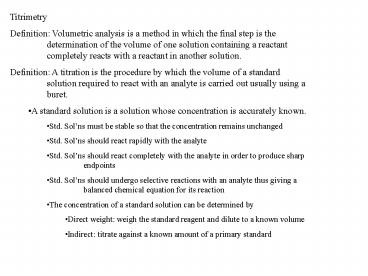Titrimetry - PowerPoint PPT Presentation
1 / 9
Title:
Titrimetry
Description:
Definition: Volumetric analysis is a method in which the final step is the determination of the ... Definition: A titration is the procedure by which the volume ... – PowerPoint PPT presentation
Number of Views:411
Avg rating:3.0/5.0
Title: Titrimetry
1
- Titrimetry
- Definition Volumetric analysis is a method in
which the final step is the determination of
the volume of one solution containing a reactant
completely reacts with a reactant in another
solution. - Definition A titration is the procedure by which
the volume of a standard solution required to
react with an analyte is carried out usually
using a buret. - A standard solution is a solution whose
concentration is accurately known. - Std. Solns must be stable so that the
concentration remains unchanged - Std. Solns should react rapidly with the analyte
- Std. Solns should react completely with the
analyte in order to produce sharp endpoints - Std. Solns should undergo selective reactions
with an analyte thus giving a balanced chemical
equation for its reaction - The concentration of a standard solution can be
determined by - Direct weight weigh the standard reagent and
dilute to a known volume - Indirect titrate against a known amount of a
primary standard
2
- Titrimetry
- The equivalence point in a titration is the point
in the titration when a chemically equivalent
amount of titrant has been added to the
analytical solution - Example In the titration of HCl with Ba(OH)2
- 2HCl Ba(OH)2 BaCl2 2H2O
- the equivalence point occurs when 1 mol Ba(OH)2
has been added to 2 mol HCl or the mole ratio
of Ba(OH)2HCl is 12 - The endpoint in a titration is the point in the
titration when a physical change occurs - Color change of an indicator
- Change in electrical resistance of the titration
mixture - Change in electrical potential of an electrode
inserted in the titration mixture - Primary Standards should
- Be obtainable in high purity
- Be stable to air and light
- Be non-hygroscopic and non-efflorescent
- Be readily available and inexpensive
- Have a high molecular weight
- Have good solubility in the solvent used for the
analysis
3
- Titrimetry
- Concentration units for solutions
- The usual unit of concentration of a species in
solution, cA, is molarity - Example What is if 30.00 mg H2SO4 is
contained in 10.35 mL solution? - Analytical molar concentration this is an
operational definition of concentration of an
analyte, regardless of the state of its
dissociation - The Equilibrium concentration is the actual
concentration of each species in solution at
equilibrium - Example Dissolving 1.000 mol H2SO4 in enough
water to make 1.000 L solution gives
1.000 M - Since H2SO4 is 100 dissociated, H2SO40.000 M
- HSO4- is 1 dissociated
- HSO4-0.99 M
- H1.01 M
- SO42-0.01 M
4
- Titrimetry
- Algebraic relationships
- (1)
- (2)
- (3)
- Example Describe how to prepare 250.0 mL of
0.1000 M AgNO3.
5
- Titrimetry
- Example Describe how to make 100.0 mL of 0.02500
M AgNO3 from 0.1000 M AgNO3. - In diluting a solution, the number of mmol solute
remains unchanged - Therefore, equation (3) can be enhanced
- 0.02500 M x 100.0 mL0.1000 x Vsoln 2
- Vsoln 225.00 mL
- To prepare the solution, place 25.00 mL 0.1000 M
AgNO3 in a 100.0 mL volumetric flask and dilute
to volume
6
Titrimetry Calculations from titration data four
step process 1 Derive a stoichiometric
relationship between the number of mmol analyte
and number of mmole of standard This usually
requires a balanced chemical equation! 2
Calculate the number of mmol of standard used
with Equation (1) or (3) 3 Convert the number of
mmol standard to mmol analyte using the results
of step 1 4 Solve for cA or weight of A using
Equations (1) and/or (2)
7
- Titrimetry
- Calculating the concentrations of standard
solutions - Example 528.0 mg KHP required 24.21 mL NaOH
solution ot reach the phenolphthalein endpoint.
What is cNaOH? - 1
- 2
- 3
- 4
8
- Titrimetry
- Calculating the concentration of a secondary
standard solution from the volume ratio of the
two solutions - Example 25.00 mL of 0.1 M HCl require 27.23 mL
of 0.1068 M NaOH to reach the phenolphthalein
endpoint. What is the molarity of the HCl
solution? - 1 HCl NaOH NaCl H2O
- 2 number mmol NaOH cNaOH x VNaOH
- 0.1068 M x 27.23 mL
- 2.908 mmol NaOH
- 3
- 4
9
- Titrimetry
- Calculation of the weight percent of analyte in a
sample - Example 1.5216 g impure KHP required 31.25 mL of
0.1068 M NaOH for complete reaction. What is the
wt. KHP in the sample? - 1 KHP NaOH NaKP H2O
- 2 number mmol NaOH cNaOH x VNaOH
- 0.1068 M x
31.25 mL 3.338 mmol NaOH - 3
- 4 rearranging equation (1)
- 5































